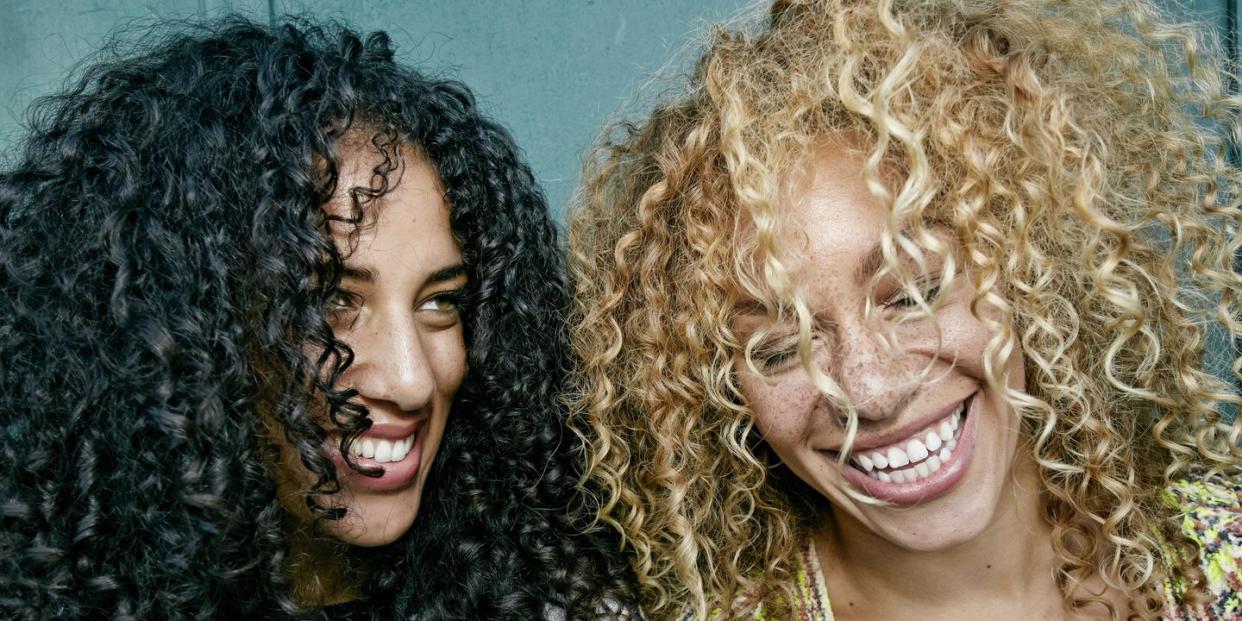How to do the Curly Girl Method

It's never been more popular to embrace your naturally curly hair, and it's a change we're welcoming with open arms. But if you're still struggling to love your natural look, it could be worth following the essential guide to looking after curly hair: the Curly Girl Method.
I know from experience that embracing your natural curls isn't always as simple as it sounds. Up until 2019, I found my curly hair unmanageable. It often felt frizzy, itchy and knotted easily, so it was easier to avoid wearing it curly altogether, and I spent years straightening it instead. Then I discovered the Curly Girl Method online, and everything shifted. Now my thick curls are bouncy and soft, I absolutely love them.
Intrigued by the thought of embracing your natural curls but not sure where to start? We've got you covered. Here is everything you need to know about the Curly Girl Method and how to do it yourself, according to an expert.
What is the Curly Girl Method?
The Curly Girl Method (CGM) originated from the book, The Curly Girl Handbook by American curl expert Lorraine Massey, and has gained a loyal following ever since.
According to Joleigh Wynter, the curl specialist behind London salon Curl Talk who was also trained by Massey, CGM is simply about looking after your curls in the kindest, gentlest way possible.
"It's essentially acknowledging that you need to treat curls differently to straighter hair types, by being more conscious of the ingredients in your products and the techniques you use," she told us.
While curly hair can be unpredictable, following CGM can help you achieve more consistent results.
Who can use the Curly Girl Method?
You don't have to have tight cork-screws or bouncy ringlets to try CGM - it's actually recommended for all textured hair types including loose waves.
"A lot of CGM focuses on using natural ingredients, which could actually be beneficial for all hair types," said Joleigh. "It's just that some ingredients can be even more damaging on curlier hair, because it's naturally drier."
How do you follow the Curly Girl Method?
Avoid shampoo
Shampoo is designed to deep-clean your hair, but that can be an issue for curlier hair types.
"Shampoo strips your hair of its natural oils," Joleigh said. "But when you have drier hair, you need those natural oils."
This doesn't mean you should get rid of cleaning your hair altogether, it just means finding products that don't contain sulphates - which are known for stripping the hair - and other harsh chemicals.
Joleigh explained that some curly girls can use just normal conditioner to clean their hair, while she personally recommends using a co-wash or hair cleanser. "These are moisturising products that are also made to clean, so they'll contain ingredients like tea tree that can activate the cleaning process," she said.
However, Joleigh stressed that so much of this is down to personal preference, and whatever works best for your hair-type.
"Some people will still need to use shampoo, but try finding one that is sulphate-free and as natural as possible," she suggested.
Remove silicones from your routine
Silicones are ingredients commonly found in conditioners, hairsprays, heat protectants and many other hair products. They're used to help give hair that glossy shine we all crave, but they're not necessarily the best thing for curls.
"Silicone is like a plastic that coats the hair," Joleigh explained. "So at first when you use silicone, you get a wonderful coating that smooths out frizz. But over time, that plastic doesn’t come off so your hair becomes even drier because the water can’t get in."
Joleigh added that, ultimately, water is the magic ingredient for curly hair. "Frizz is just dehydrated curls, so if you want hydrated curls without frizz, you need to allow as much water as possible in," she said.
For similar reasons, Joleigh also prefers to leave finishing oils out of curly hair routines. "Many oils coat the hair which stops water getting in," she said.
Style and scrunch
If you want to make your curls pop, the products you use after you wash your hair are really important.
"I like using a three-step process," Joleigh told us. "First, I start with a leave-in conditioner, which helps the water to seep into the hair. Then I use a curl cream and a gel."
Again, it's important to ensure your products don't contain any ingredients that could be harsh on your curls - Joleigh recommended a site called Curlsbot, where you can copy and paste ingredient lists to help you decipher which ingredients might damage your hair.
Joleigh suggested applying cream before gel and scrunching your hair in an upward motion - you should hear it squish, and you should start seeing curl patterns form even while wet. If you put too much gel in and it feels crunchy, don't worry - this is called a 'cast' and you can scrunch this out, using some water, once your hair dries.
Deep conditioning
As curls are drier, they need extra hydration, so Joleigh always recommends using a mask or deep conditioner on your hair every now and again. How often you choose to do it will depend on your hair needs.
"Unless your hair is damaged, I wouldn't recommend doing one every week," Joleigh said. "Curly hair can be high maintenance and it gets bored easily - I find if you do it every few weeks, your hair will enjoy it more."
However, it is possible to over-moisturise your hair!
"If you feel like your hair is almost too-soft and the curls are going limp, you can try a mask that contains protein, or a rice water rinse," Joleigh said, which can help bring your curls back to life.
Dry carefully
If you always dry your hair with a towel, you might want to think again. "The friction from using towels can cause extra frizz in curly hair," said Joleigh.
Of course, there's nothing wrong with frizz if that's what you like, but according to Joleigh, frizz should always be a choice.
While microfibre towels are a gentler, more popular alternative, Joleigh said they're still not ideal as they absorb a lot of water very quickly - and again, the name of the game is to retain as much water as possible. Instead, she always recommends wrapping your hair in a humble t-shirt. And while the original CGM promotes air-drying, Joleigh also recommended using a diffuser on a colder setting.
Gentle knot-removing
The Curly Girl Handbook advises against any brushing at all, suggesting you should use your fingers to brush through your curls while wet with conditioner, so as not to damage your curl pattern. But Joleigh recognises this is not always possible for every hair type.
"Some people use a wide-toothed comb, while I personally like to use a Denman brush," she said. Sometimes, you need an extra helping hand to get those knots out. Still, make sure you only brush while your hair is wet with conditioner.
Sleeping on silk
Always wake up with matted, knotted hair? You're not alone. But according to CGM, this can be easily solved by using a silk or satin pillowcase or hair bonnet.
"The silk is much kinder to curls, and I've even noticed a difference to my skin when I use a pillowcase," Joleigh said. "It's far less abrasive."
She also recommends sleeping with your hair in a 'pineapple' - a loose bun - using a satin scrunchie so as not to dent your curls.
Refreshing
It makes sense that your curls might not always be in the best state when you wake up, but instead of reaching for your straighteners, you can put some product in to refresh them. Spray your hair with water and use a bit of leave-in conditioner, or any other curl creams or CGM-approved sprays. Just make sure you add water!
What else do I need to know about the Curly Girl Method?
Remember, you don't have to follow CGM to the letter. Joleigh was quick to mention that everyone's hair is different - in fact, every curl on a single head is different! - so it's important to find what works for you. But using CGM as a spring-board can be a great place to start.
Good luck on your curl journey!
Find Joleigh Wynter on Instagram: @curl.talk
Like this article? Sign up to our newsletter to get more articles like this delivered straight to your inbox.

You Might Also Like


